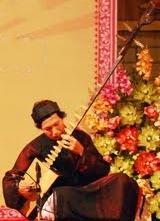Д‘Г n Д‘ГЎy on:
[Wikipedia]
[Google]
[Amazon]

 The ''Д‘Г n Д‘ГЎy'' (
The ''Д‘Г n Д‘ГЎy'' (
''ДђГ n Д‘ГЎy'' page

 The ''Д‘Г n Д‘ГЎy'' (
The ''Д‘Г n Д‘ГЎy'' (Chб»Ї NГґm
Chб»Ї NГґm (, ; ) is a logographic writing system formerly used to write the Vietnamese language. It uses Chinese characters ('' Chб»Ї HГЎn'') to represent Sino-Vietnamese vocabulary and some native Vietnamese words, with other words represent ...
: еЅ€рЎЊ )is a Vietnamese plucked lute with three strings, a trapezoidal wooden body, and a very long wooden neck with ten raised frets. Players formerly used silk
Silk is a natural protein fiber, some forms of which can be woven into textiles. The protein fiber of silk is composed mainly of fibroin and is produced by certain insect larvae to form cocoons. The best-known silk is obtained from the ...
strings, but since the late 20th century have generally used nylon
Nylon is a generic designation for a family of synthetic polymers composed of polyamides ( repeating units linked by amide links).The polyamides may be aliphatic or semi-aromatic.
Nylon is a silk-like thermoplastic, generally made from pe ...
.
Usage
It is used primarily in Northern Vietnam, and is one of the accompanying instruments used in ''ca trГ№
''Ca trГ№'' (, , "tally card songs"), also known as hГЎt cГґ Д‘бє§u or hГЎt nГіi, is a Vietnamese genre of musical storytelling performed by a featuring female vocalist, with origins in northern Vietnam. For much of its history, it was associated ...
''.
In the late 20th century, a modernized version of the electric bass guitar
The bass guitar, electric bass or simply bass (), is the lowest-pitched member of the string family. It is a plucked string instrument similar in appearance and construction to an electric or an acoustic guitar, but with a longer neck and sc ...
in the shape of the ''Д‘Г n Д‘ГЎy'' was developed for use in the neo-traditional music composed and performed at the Hanoi Conservatory. Unlike the ''Д‘Г n Д‘ГЎy'', this instrument has a solid wooden body and metal strings, and without raised frets.
Etymology
In theVietnamese language
Vietnamese ( vi, tiếng Việt, links=no) is an Austroasiatic languages, Austroasiatic language originating from Vietnam where it is the national language, national and official language. Vietnamese is spoken natively by over 70 million people, ...
, ''Д‘Г n'' is a classifier used primarily to refer to string instruments, and ''Д‘ГЎy'' means "bottom." Thus, the instrument's name translates literally as "bottom string instrument." However, the instrument's body has no back. According to one online source, the instrument was originally called ''vГґ Д‘б»ѓ cбє§m'', literally "bottomless stringed instrument."
See also
*Music of Vietnam
Traditional Vietnamese music encompasses a large umbrella of Vietnamese music from antiquity to present times, and can also encompass multiple groups, such as those from Vietnam's ethnic minority tribes.
History
Traditional Vietnamese music has ...
* Traditional Vietnamese musical instruments
References
External links
''ДђГ n Д‘ГЎy'' page
Video
* Vietnamese musical instruments Necked lutes {{lute-stub